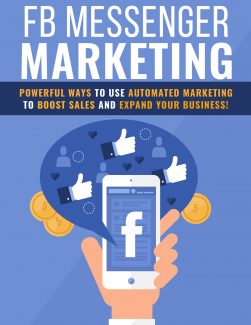 License Type: Private Label Rights
License Type: Private Label Rights  File Type: ZIP
File Type: ZIP
 SKU: 63090
SKU: 63090  Shipping: Online Download
Shipping: Online Download
Sample Content Preview
Introduction
In order to have your business succeed in the current market, it’s imperative that you build and maintain a strong online presence. With customers demanding answers at all hours of the day, regardless of what they’re doing or where they are, you should consider using a Facebook Messenger Chatbot.
A chatbot is an Artificial Intelligence (AI), interactive messaging system that engages with your customers on behalf of your company, all within Facebook’s popular messenger. And for the most part, no human is required.
From learning the basics of how to create one using a bot-building service, to knowing what features yours should have, and what it should look like, you’ll soon be on the way to having basic inquiries on products and services to sales, sometimes within minutes.
Gone are the days of people only being able to call customer service Monday through Friday, 8am - 5pm.
Not only do they want answers to their questions right away, but they no longer have to leave their home in order to make a purchase. An interactive chatbot is the perfect tool for any online business.
Technology is here to stay, and customers love how it saves them so much time. Chatbots will save you both time and money, since it takes away the cost of traditional person-filled labor positions.
So, if you’d like more information on how to successfully build one, keep reading!
Tip #1: Customer FAQ’s
When creating a chatbot for your Facebook messenger marketing campaign, you may feel overwhelmed at what you should and should not include in it. After all, you don’t want to inundate your customer with so much information that they lose interest in your product.
Which is why you should refer to your company’s most Frequently Asked Questions (FAQ’s).
Consider sending out a broadcast email or hosting a Facebook Live session, and see what questions pop up during your event. You can discuss your product during the event or even just use it as a basic, get to know us interaction with your audience.
Pay attention to the questions that keep popping up the most. For example, do you offer discounted or free shipping on large orders, free exchanges and returns, promotions, etc. When you go to build your Facebook messenger chatbot, include these FAQ’s so that customers can easily interact with them within the platform.
While current and potential new customers are learning more about your business, it’ll all be done through a chatbot that’s been crafted with your own personal touch. Customers don’t want to hear a basic ‘yes’ or ‘no.’ Even though they know they’re talking with a chatbot, they still want that human touch.
For more tips on how to personalize your chatbot for your own business, check out this article from Entrepreneur that gives some great tips and tricks to keeping your customers engaged.
https://www.entrepreneur.com/article/294418
Tip #2: Automated Greeting
After you decide on what Customer FAQ’s to add to your Facebook Messenger Chatbot, you should consider creating a warm and inviting automated greeting.
A potential customer is browsing your Facebook page, taking a look at customer comments and your posts, and they decide to reach out to your chatbot. While you may think a basic ‘Hello’ is good enough, the truth is that customers don’t want good enough.
They want to be wowed!
And with so many companies out there nowadays, it’s imperative that you make yours stand out. So, think outside the box and refrain from something generic. Consider a greeting that is a bit more welcoming such as, “Greetings, and welcome to [name of company]. What brings you here today?”
Remember that when you’re in a sales environment, that it’s important to ask open-ended questions. Saying something like, “Are you having a good day?” or “Can we interest you in [insert product]?” will either result in a bail out or a negative response. Encourage the customer to have an engaging conversation with your chatbot.
While the customer is interacting with your chatbot, offer multiple choice answers that gradually narrow down to very specific questions tailored to their needs.
A simple “I’m interested in your body lotion, but the price is a little too high for me,” can lead to a sale of either something else you offer, or a discount if they get it with another product.
Just remember to keep the customer engaged in a casual conversation. Don’t be too pushy, and don’t sound robotic. Be warm and inviting, and make it seem as though they’re really talking with a human. And of course, allow them to exit the chatbot at any time. Customers never want to feel obligated into doing something they don’t want to!
There are lots of successful chatbots out there for you to look at, and we encourage you to do so. You can get an idea of how you want yours to look as well.
Pay attention to the ones that are the most successful, and think about how a similar one would work well for your own business.
For an idea of what a successful chatbot looks like, as well as other tips for making yours just as successful, check out Marketing360.com. It’s full of information you can put to good use with your own chatbot.
Tip #3: Casual Conversation Vs. Shop Button
If you’ve ever visited a Facebook business page, then you might have seen a Shop button on it. It’s pretty self-explanatory: customers can simply click on that button, and it takes them to an eCommerce store.
But customers don’t need to engage with a chatbot in order to hit that button. So, should you bother putting one into your chatbot?
It’s a good idea to have a shop button, but you want to encourage customers to interact with your chatbot rather than just hitting that button. Especially since interacting with a chatbot has a better chance of having them spend more money, whereas just hitting the shop button will result in them buying what they’re looking for, and not what your chatbot recommends based on their conversation.
- License: Private Label Rights
- Category:Ebooks
- Tags:2020 Ebooks Private Label Rights








